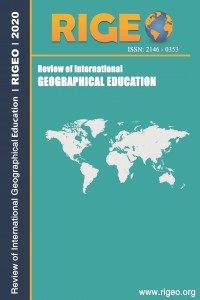Awareness of Primary Teachers about Teaching Location and Direction Concepts
Awareness of Primary Teachers about Teaching Location and Direction Concepts
The aim of this study is to determine the awareness of primary teachers about the teaching of location and direction concepts. The study was designed according to a qualitative research model, and the data was collected through a semi-structured interview form developed by researchers consisting of open-ended questions. The study group consisted of seven primary teachers working in Eskişehir, Mersin and Nevşehir provinces of Turkey. In determining the study group, the convenience sampling technique was used from purposeful sampling methods. The interviews were conducted in the fall semester of the 2020-2021 academic year and the data obtained were analyzed by content analysis. The study findings showed that participants were aware that the concepts of “location” and “direction” constitute a necessity in the curriculum and that the teaching of these concepts provides benefits and convenience to students both in school life and in daily life practice.
Keywords:
Location, diection, primary teacher,
___
- Aydınözü, D., Demirbaş, İ. & Demir, B.D. (2020). Classroom teachers’ opinions on gaining gains related to direction and direction finding in primary school students. International Journal of Geography and Geography Education (IGGE), 41, 59-72.
- Bogdan, R.C., & Biklen, S.K. (2003). Qualitative research for education: An introduction to theories and methods (4th ed.). New York, NY: Pearson Education Group.
- Çepni, O. (2019). Location analysis. In Skills training in social studies (pp. 146-170), Eds.: B. Aksoy, B. Akbaba, B. Kılcan, Ankara: Pegem Academy.
- Demirkaya, H., Çetin, T. & Tokcan, H. (2004). The Methods That Can Be Used in Teaching the Concept of Direction in Primary Education. Gazi University Journal of Gazi Educational Faculty, 24(3), 39-70.
- Dubois, P.J. & Rousseau, E. (2020). A short philosophy of birds (Trans.: M. Erşen). İstanbul: Domingo Press.
- Gagnier, K. & Fisher, K. (2016). Spatial thinking: What it is, and why it matters for STEM education. available at: https://jscholarship.library.jhu.edu/bitstream/handle /1774.2/63010/spatialthinkingmastheadfinal.pdf?sequence=1&isAllowed=y, 04.11.2020
- Glesne, C. (2013). Introduction to qualitative research (Trans. Eds.: P. Yalçınoğlu & A. Ersoy). Ankara: Anı Press.
- Golledge R.G. (2004). Spatial Cognition (pp. 443-452). In The Encyclopedia of Applied Psychology, Spielberger C. (Ed.), Amsterdam: Elsevier Ltd.
- Jordan, K., Wüstenberg, T., Jaspers-Feyer, F., Fellbrich, A. & Peters M. (2006). Sex differences in left/right confusion. Cortex, 42, 69-78.
- Koç, H., Aksoy, B. & Çiftçi, T. (2017). An examination of map literacy levels of students from various undergraduate programmes according to several variables: Cumhuriyet university sample. Erzincan University Journal of Education Faculty, 19(3), 301-321.
- Köşker, N. (2012). Thoughts of prospective class teachers on their spatial cognitive adequacy. Zeitschrift für die Welt der Türken, 4(3), 161-172.
- Leymun, Ş.O. (2017). The importance of case study research in educational settings. ENAD Online, 5(3), 369-385.
- Miles, M.B. and Huberman, A.M. (1994). Qualitative data analysis. Thousand Oaks, CA: Sage.
- National Research Council. (2006). Learning to think spatially. Washington, DC: The National Academies Press.
- Patton, M. Q. (1990). Qualitative evaluation and research methods. USA: Sage.
- Safi, H. (2010). Teachers' views on the development of the space perception skill in the social studies curriculum. Master's thesis, Marmara University Institute of Education Sciences, Istanbul.
- Sönmez, Ö.F. & Aksoy, B. (2012). Determination of primary education secondary stage students' map skill levels. Turkish Studies, 7(1), 1905-1924. TDK (1998). Turkish dictionary-2 (K-Z). Ankara: Turkish Historical Society Printing House.
- Tuna, F., Demirci, A. & Gültekin, N. (2012). To what extent are basic geographic knowledge and skills used in society? Current situation analysis in direction, location and map skills. National Education, 195, 211-227.
- Uttal, D.H., Meadow, N.G., Tipton, E., Hand, L.L., Alden, A.R., Warren, C., & Newcombe, N.S. (2013). The malleability of spatial skills: a meta-analysis of training studies. Psychological Bulletin, 139(2), 352.
- Yin, R.K. (1998). The abridged version of case study research. In L. Bickman, D.J. Rog (Eds), Handbook of applied social research methods, Sage, Thousand Oaks CA.
- ISSN: 2146-0353
- Başlangıç: 2011
- Yayıncı: Eyüp ARTVİNLİ
Sayıdaki Diğer Makaleler
A Study on Environmental Literacy Levels of Social Studies Teacher Candidates
Awareness of Primary Teachers about Teaching Location and Direction Concepts
Nilgün DAĞ, Bülent AKSOY, Halis Adnan ARSLANTAŞ
Elçin AYAZ, Okan DORUK, Rabia SARIKAYA
Examination of Studies Aimed at Developing Map Skills in Secondary School Students: A Meta-Analysis
Elvan YALÇINKAYA, Ayten KARACA
Raziya KALDYBEKOVA, Bülent AKSOY, Bahadurkhan ABDYMANAPOV
